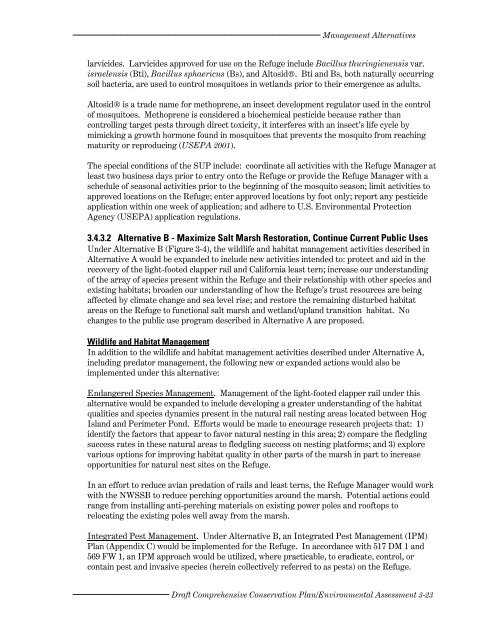Chapters 1 - U.S. Fish and Wildlife Service
Chapters 1 - U.S. Fish and Wildlife Service
Chapters 1 - U.S. Fish and Wildlife Service
You also want an ePaper? Increase the reach of your titles
YUMPU automatically turns print PDFs into web optimized ePapers that Google loves.
Management Alternatives<br />
larvicides. Larvicides approved for use on the Refuge include Bacillus thuringienensis var.<br />
israelensis (Bti), Bacillus sphaericus (Bs), <strong>and</strong> Altosid®. Bti <strong>and</strong> Bs, both naturally occurring<br />
soil bacteria, are used to control mosquitoes in wetl<strong>and</strong>s prior to their emergence as adults.<br />
Altosid® is a trade name for methoprene, an insect development regulator used in the control<br />
of mosquitoes. Methoprene is considered a biochemical pesticide because rather than<br />
controlling target pests through direct toxicity, it interferes with an insect’s life cycle by<br />
mimicking a growth hormone found in mosquitoes that prevents the mosquito from reaching<br />
maturity or reproducing (USEPA 2001).<br />
The special conditions of the SUP include: coordinate all activities with the Refuge Manager at<br />
least two business days prior to entry onto the Refuge or provide the Refuge Manager with a<br />
schedule of seasonal activities prior to the beginning of the mosquito season; limit activities to<br />
approved locations on the Refuge; enter approved locations by foot only; report any pesticide<br />
application within one week of application; <strong>and</strong> adhere to U.S. Environmental Protection<br />
Agency (USEPA) application regulations.<br />
3.4.3.2 Alternative B - Maximize Salt Marsh Restoration, Continue Current Public Uses<br />
Under Alternative B (Figure 3-4), the wildlife <strong>and</strong> habitat management activities described in<br />
Alternative A would be exp<strong>and</strong>ed to include new activities intended to: protect <strong>and</strong> aid in the<br />
recovery of the light-footed clapper rail <strong>and</strong> California least tern; increase our underst<strong>and</strong>ing<br />
of the array of species present within the Refuge <strong>and</strong> their relationship with other species <strong>and</strong><br />
existing habitats; broaden our underst<strong>and</strong>ing of how the Refuge’s trust resources are being<br />
affected by climate change <strong>and</strong> sea level rise; <strong>and</strong> restore the remaining disturbed habitat<br />
areas on the Refuge to functional salt marsh <strong>and</strong> wetl<strong>and</strong>/upl<strong>and</strong> transition habitat. No<br />
changes to the public use program described in Alternative A are proposed.<br />
<strong>Wildlife</strong> <strong>and</strong> Habitat Management<br />
In addition to the wildlife <strong>and</strong> habitat management activities described under Alternative A,<br />
including predator management, the following new or exp<strong>and</strong>ed actions would also be<br />
implemented under this alternative:<br />
Endangered Species Management. Management of the light-footed clapper rail under this<br />
alternative would be exp<strong>and</strong>ed to include developing a greater underst<strong>and</strong>ing of the habitat<br />
qualities <strong>and</strong> species dynamics present in the natural rail nesting areas located between Hog<br />
Isl<strong>and</strong> <strong>and</strong> Perimeter Pond. Efforts would be made to encourage research projects that: 1)<br />
identify the factors that appear to favor natural nesting in this area; 2) compare the fledgling<br />
success rates in these natural areas to fledgling success on nesting platforms; <strong>and</strong> 3) explore<br />
various options for improving habitat quality in other parts of the marsh in part to increase<br />
opportunities for natural nest sites on the Refuge.<br />
In an effort to reduce avian predation of rails <strong>and</strong> least terns, the Refuge Manager would work<br />
with the NWSSB to reduce perching opportunities around the marsh. Potential actions could<br />
range from installing anti-perching materials on existing power poles <strong>and</strong> rooftops to<br />
relocating the existing poles well away from the marsh.<br />
Integrated Pest Management. Under Alternative B, an Integrated Pest Management (IPM)<br />
Plan (Appendix C) would be implemented for the Refuge. In accordance with 517 DM 1 <strong>and</strong><br />
569 FW 1, an IPM approach would be utilized, where practicable, to eradicate, control, or<br />
contain pest <strong>and</strong> invasive species (herein collectively referred to as pests) on the Refuge.<br />
Draft Comprehensive Conservation Plan/Environmental Assessment 3-23

















